Navigating a New Ethical Maze: AI in Home-Based Care Marketing
Artificial intelligence (AI) – whether you love it or loathe it – is here to stay. The integration of AI into healthcare marketing represents both an unprecedented opportunity and a profound responsibility. As home-based care organizations and marketing agencies increasingly leverage AI to reach patients, family caregivers and referral sources, the need for ethical guidelines has never been more critical.
The Good, Bad and Ugly of AI-Driven Healthcare Marketing
AI platforms offer home-based care marketers powerful tools to identify at-risk populations, predict patient needs, and deliver targeted health information. Machine learning algorithms can analyze vast datasets to uncover patterns, creating a path for more effective outreach when engaging referral sources to increase patient census.
However, these capabilities raise significant ethical concerns. The sensitive nature of health information, combined with AI’s potential for bias and manipulation, creates risks that extend beyond privacy violations to include discrimination, misinformation and erosion of patient trust. Developing an ethical approach to utilizing AI within each organization can help mitigate potential risks down the line.
Core Ethical Principles for AI in Healthcare Marketing
The use of AI in marketing strategies should align with key aspects of the medical ethical principles that already guide hospice care organizations today.
- Beneficence involves using AI platforms to maximize benefits while minimizing risks, or rather, do no harm.
- Non-maleficence requires protecting the dignity and quality of life of the patients and families who need you.
- Autonomy requires that patients and families receive accurate information to make truly informed decisions about their health.
- Justice demands that healthcare marketing promotes equitable access to healthcare information and services.

Seven Guidelines for the Ethical Use of AI in Home-Based Care Marketing
1. Use AI as a Tool, not a Total Solution
There are helpful tools that support productivity (e.g., summarizing meeting notes or internal reports). AI platforms such as Claude or ChatGPT can be a good option for brainstorming ideas if you’re feeling stuck, but you risk blending in with every other organization and potential legal concerns when using AI-driven creative.
2. Implement Bias Testing and Mitigation
Regularly audit AI systems for discriminatory patterns across demographic groups. Remember, every bit of information on AI platforms stems from people all over the world. We all have biases and it’s important to recognize and remove them from your marketing strategy and materials. Ensure algorithms don’t perpetuate historical healthcare disparities or exclude underserved populations.
3. Protect Personal Privacy
This is an example of beneficence. Although doing harm isn’t always intentional, in this new world that we’re living in, it’s important to practice vigilance when handling even the smallest bit of personal data. Prior to uploading content to an AI platform, remove any personal identification information to protect those involved.
4. Maintain Human Oversight
AI should augment, not replace, human judgment in healthcare marketing decisions. It is increasingly common for the information shared from AI platforms to be inaccurate. An experienced professional should always review AI-generated recommendations and content. If the AI tool you’re using provides any statistics or data, always check the source to ensure the information is accurate and the source is credible.
5. Establish Clear Consent Mechanisms
While many people are adapting to utilizing AI, not everyone is on board. Develop consent frameworks that account for AI’s dynamic nature. Provide easily accessible opt-out procedures that are genuinely honored.
6. Maintain Authenticity
Transcend Strategy Group’s research insights from patients and families clearly demonstrate the preference for engaging organizations that genuinely care for their loved ones. The first impression of an organization will almost always be its branding and marketing. People are getting better at identifying AI-generated language and grammatical patterns, and the last thing you want is to come across as inauthentic. Ensure your brand’s voice is detectable throughout your messaging.
7. Create Accountability Structures
Establish governance frameworks with diverse stakeholder representation, including sales/marketing and clinicians, in AI oversight decisions.

The Path Forward
While AI offers powerful tools for improving health communication, implementation should always be guided by established ethical principles and rigorous oversight.
By prioritizing transparency, equity, privacy and accountability, home-based care organizations can harness AI’s benefits while maintaining the trust essential to delivering care to the communities that depend on them. The stakes are too high, and patient trust is too precious to accept anything less than the highest ethical standards in this intersection of technology, marketing and health.











